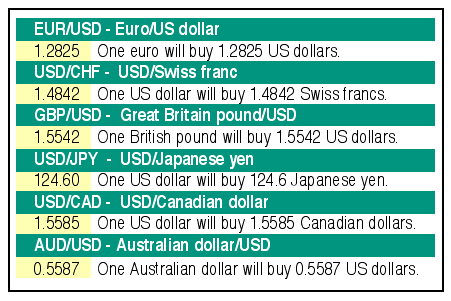What?…Why?…How?
Forex, Anyone?
by Rudy Teseo
It may be easier than you think.
When I first read about foreign currency trading and foreign exchange (FX or forex for short), my first reaction was, "That's not for me." Perhaps that's been your attitude. However, when I decided to install a program and do some paper-trading before committing any hard-earned dollars, I was amazed at how easily I slipped into the routine. That's because there's very little difference between what I'm doing now and what I've been doing for years.
NUTS AND BOLTS
FX is the largest financial market, trading $2.5-3 trillion per day. It is open 24 hours per day, except for a break from 4 pm ET Friday to 2 pm ET Sunday. With more than two dozen currency pairs to choose from, there is always action to suit your style. Executions are instantaneous, the pairs are very liquid, and the leverage in the two types of accounts is the highest found anywhere. For option traders, there are some unique contracts available in FX with large gains possible. FX also provides one of the best trending markets, and trends lead to profitable trades. A final difference: you can short a currency pair without an uptick.
Foreign exchange is an exchange where one country's currency is exchanged for another's through a "floating" exchange rate system. There is no central exchange, like the New York Stock Exchange (NYSE). What you have is a network of banks running the exchange electronically.
Before you start trading forex, there's quite a bit of studying to do. It's not as simple as buying 100 shares of XYZ at $60 with a stop-loss at $55. But nor is options or commodities simple; each has its own terminology, techniques, and procedures. And so it is with FX.
In the FX arena, you are essentially trading the exchange rate between two currencies. These can be the US dollar (USD) and the euro (EUR), or it can be between two foreign currencies, such as the EUR and the British pound (GBP). As you can imagine, the exchange rate is constantly changing due to the fluctuation in value of the different currencies when compared to other currencies.
So you are always trading a currency pair. These are fixed, and there are currently 18 actively traded pairs, although some programs offer additional pairs. For Figure 1, I will only describe the major currency pairs, so-called because they have the highest volume and liquidity. Also shown are typical exchange rates as of this writing.

FIGURE 1: MAJOR CURRENCY PAIRS. Here you see the currency pairs listed that have the highest volume and liquidity.
...Continued in the July issue of Technical Analysis of STOCKS & COMMODITIES
Excerpted from an article originally published in the July 2005 issue of Technical Analysis of STOCKS & COMMODITIES magazine. All rights reserved. © Copyright 2005, Technical Analysis, Inc.
Return to July 2005 Contents